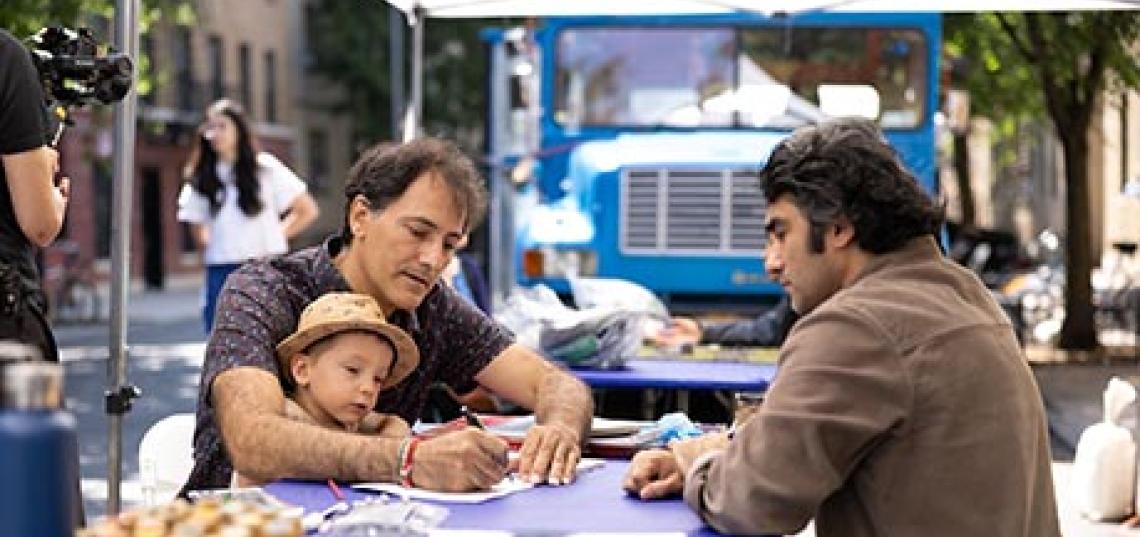
Immigrants face a particularly stressful set of challenges while adapting to their new homelands, and often foremost among these are language and communication barriers.
Through his work as an author, educator, and interdisciplinary artist at the intersections of visual culture, language, and digital communication, Assistant Professor of Library and Information Science Ali Motamedi explores what these forms of language mean in today’s society and in our personal lives.
"The impact I aim for is a deeper public understanding of how communication is rooted in belonging and memory, not just words," said Motamedi. "My own migration experience sharpened my awareness of language and voice—what disappears, and what new forms emerge in between."
Holding a Ph.D. in Civil Engineering (in Quantitative Risk Management) and a Master of Fine Arts, Motamedi merges technical and artistic methodologies to explore communication across borders.
Motamedi's most recent works include two forthcoming books: "We've Arrived Home" (in Farsi), which explores themes of immigration and belonging, and "Farsi Flows," a bilingual experimental project that blends visual and textual expression.
Motamedi has also been invited to deliver several talks about his work during 2025 and 2024, including:
- Language, displacement, and creative practice at ACAF Talking Peers (Arts for Afghanistan);
- Writing, immigration, and identity at City Lore, New York City; and
- The intersections of immigration, art, and technology at the Northeastern University Boston Literary Club.
 In our Q&A, Motamedi describes his body of work and explains why 2025 is a particularly important time to develop and expand new ways to overcome communication barriers.
In our Q&A, Motamedi describes his body of work and explains why 2025 is a particularly important time to develop and expand new ways to overcome communication barriers.
How do you describe your work and its impact on increasing the public’s understanding of communication and immigration?
AM: My work grows out of the Farsi language and Persian culture, and extends into visual art, writing, and education. I create forms—books, installations, and classrooms—that invite reflection on migration, displacement, and cultural in-betweens.
How can art and technology help people communicate when language fails?
AM: Art creates its own vocabulary—through images, gestures, and forms—that can carry meaning when spoken language cannot. Technology extends these vocabularies, allowing them to cross borders, reach new audiences, and be preserved across generations. For immigrants and multilingual communities, this opens pathways of dignity, connection, and visibility.
Through your writing, installations, and teaching, do you explore current immigration and identity issues in America? AM: Yes, I believe my work does engage with these issues. For me, art has always been a way to open space for reflection and connection, whether through writing, installations, or teaching. Immigration and identity are not only part of today’s political climate but have always shaped our societies. Art cannot solve these challenges outright, but it can shift perspectives, create empathy, and give voice to experiences that are often overlooked.
Why are these insights important in 2025?
AM: At a time of intense migration, global polarization, and technological change, communication across cultural lines is more urgent than ever. These works remind us that cultural roots—like Farsi and Persian traditions—can offer resilience while opening space for dialogue with other worlds. They argue for empathy and creativity as tools of communication where politics often fail.
Tell us about your forthcoming books "We’ve Arrived Home" and "Farsi Flows."
AM: "We’ve Arrived Home" is a forthcoming collection of Farsi essays on immigrant life and the search for home. It gives voice to the complexities of being between cultures. "Farsi Flows" is one of the first experimental works of its kind, connecting two separate worlds—East and West—through a bilingual exploration of writing. It blends legible and asemic forms of Farsi to show how language itself can become a bridge. Both projects highlight how communication carries memory and how immigrant stories can reshape collective understanding.
What classes are you teaching this semester?
AM: I am teaching several sections of Information Visualization. The course combines critical design, technology, and storytelling with data, helping students see information as both a cultural and technical practice.
How do you hope to have the greatest impact on your students?
AM: By showing them that data, stories, and culture are inseparable, and by encouraging them to approach technical work with creativity, inclusivity, and cultural awareness. I hope they leave with the ability to shape their own narratives while listening more deeply to others.
How has your work evolved?
AM: I began with photography and personal essays, working through themes of displacement and belonging. Over time, I’ve expanded into participatory and cross-disciplinary projects that invite collective voices, while always rooted in the spirit of Farsi and Persian culture.
Learn more about the Library and Information Science Department at the Rutgers School of Communication and Information on the website.
Photos: Top: Austin Kim (Motamedi pictured to the right); bottom: courtesy of Ali Motamedi
Update:
Coming up on September 28, 2025 in Queens, NYC: New performance "Where Language Ends" at the International Human Rights Festival (Tickets available here).
